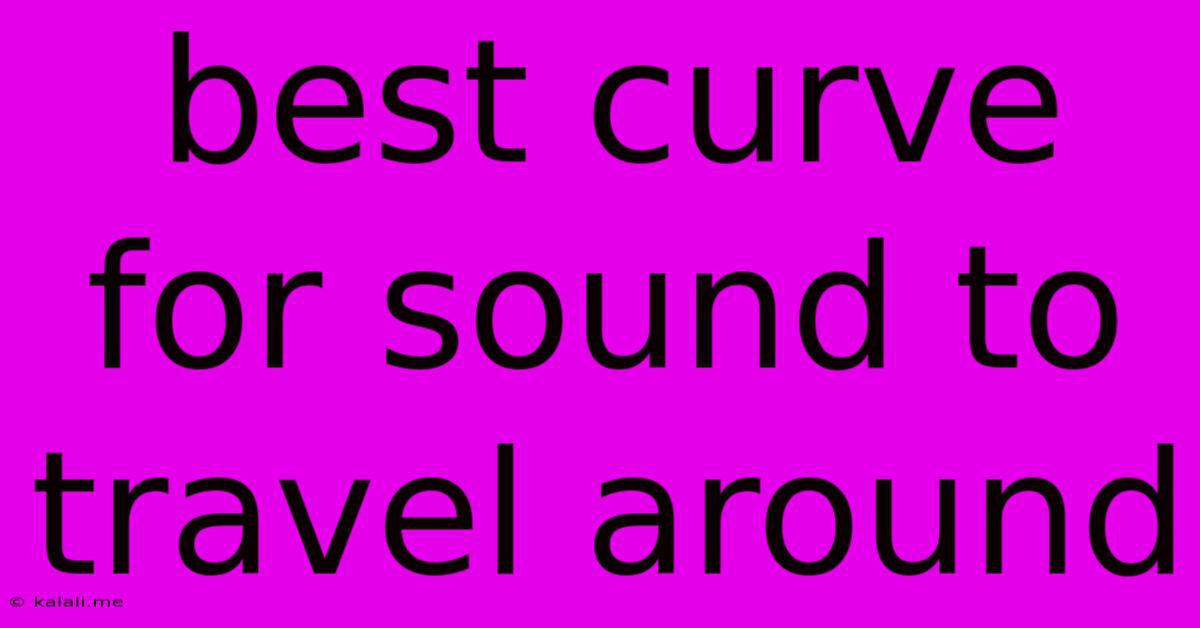Best Curve For Sound To Travel Around
Kalali
Jun 09, 2025 · 3 min read

Table of Contents
Best Curve for Sound to Travel Around: Exploring Architectural Acoustics
Sound, a wave phenomenon, doesn't travel in a straight line indefinitely. Obstacles, reflections, and the very nature of the medium it travels through influence its path. Understanding how sound curves and bends is crucial in fields like architectural acoustics, where designing spaces for optimal sound propagation is paramount. This article explores the best curve, or rather, the best combination of factors, that allow for effective sound travel around obstacles and within enclosed spaces. There isn't one single "best" curve, but rather principles that architects and sound engineers utilize.
Understanding Sound Diffraction and Reflection
Before delving into curves, it's vital to understand the fundamental principles governing sound's behavior:
-
Diffraction: Sound waves, especially low-frequency ones, can bend around obstacles. This phenomenon, known as diffraction, is more pronounced with larger wavelengths and smaller obstacles. Think about hearing a conversation from around a corner – that's diffraction in action. The size of the obstacle relative to the wavelength is key; a smaller obstacle relative to the wavelength will cause more diffraction.
-
Reflection: When sound waves hit a hard surface, they bounce back. This reflection significantly impacts sound within a space, creating echoes, reverberations, and influencing overall sound quality. The angle of incidence (the angle at which the sound hits the surface) equals the angle of reflection. The material of the reflecting surface also greatly impacts the reflection – hard, smooth surfaces produce stronger reflections than soft, porous ones.
Designing for Optimal Sound Propagation: It's Not Just About Curves
While a perfectly curved surface might seem ideal for guiding sound, reality is more nuanced. The "best" approach involves a thoughtful combination of factors:
1. Surface Material and Shape:
-
Absorptive materials: In spaces where sound clarity is paramount (like concert halls or recording studios), strategically placed absorptive materials (e.g., acoustic panels, carpets) minimize unwanted reflections and echoes. These materials don't necessarily create a curve, but they manage the sound's energy.
-
Reflective surfaces: Carefully positioned and shaped reflective surfaces can direct sound waves to specific areas, maximizing sound projection and evenness within a space. Curved surfaces can be part of this, but their curvature should be carefully calculated based on the desired sound distribution. Concave surfaces focus sound, while convex surfaces diffuse it.
2. Room Geometry and Size:
The shape and size of the space drastically influence sound propagation. A rectangular room, for example, will likely produce distinct echoes and standing waves (points of high and low sound pressure). Irregular shapes and strategically placed diffusers can minimize these issues and improve sound distribution.
3. Sound Source Placement:
The location of the sound source is critical. Placing the sound source in relation to reflective surfaces can enhance or diminish its impact.
4. Audience Positioning:
Understanding how sound reflects and travels within a space allows for optimal audience placement, ensuring even sound distribution for listeners.
Conclusion: A Holistic Approach
The "best curve" for sound to travel around isn't a singular, definitive answer. Instead, it's a multifaceted design problem that necessitates a holistic approach, considering surface materials, room geometry, sound source placement, and audience positioning. While curves can play a role—particularly concave surfaces for focusing sound or convex surfaces for diffusion—their effectiveness is intertwined with these other factors. Effective acoustic design is about creating a balanced system where sound is optimally controlled and distributed to achieve the desired sonic outcome.
Latest Posts
Latest Posts
-
How Many Numbers Are Between 48 To 24
Jul 02, 2025
-
How Many Positions Are There In Sex
Jul 02, 2025
-
How Many Minutes Are In 10 Miles
Jul 02, 2025
-
How Many Milliseconds Are In A Day
Jul 02, 2025
-
If Your 16 What Year Were You Born
Jul 02, 2025
Related Post
Thank you for visiting our website which covers about Best Curve For Sound To Travel Around . We hope the information provided has been useful to you. Feel free to contact us if you have any questions or need further assistance. See you next time and don't miss to bookmark.